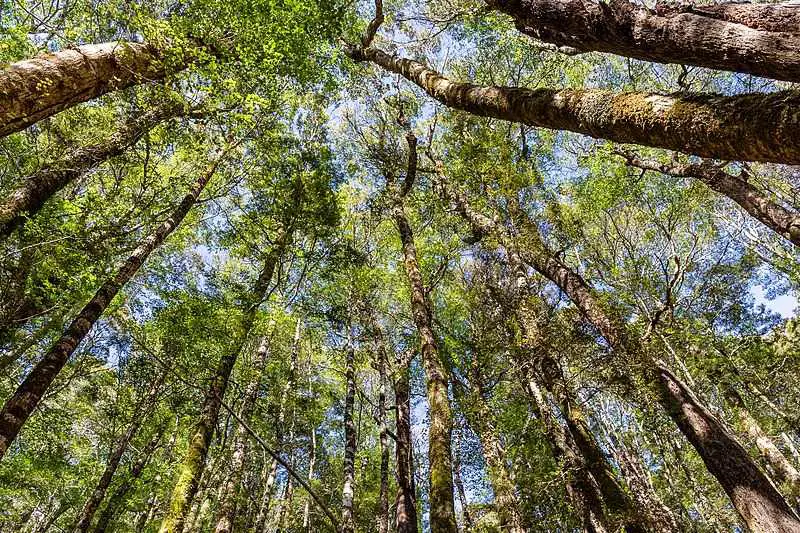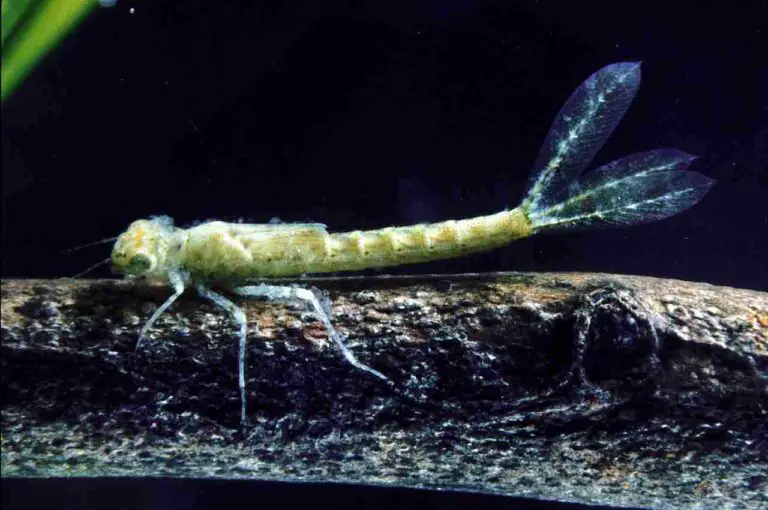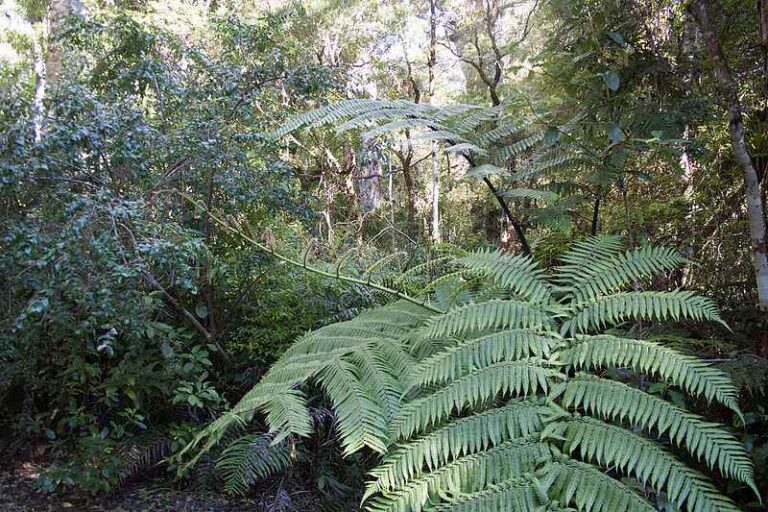Temperate Forest Plants and Their Characteristics Discussed
Temperate forest plants are; vascular plants like trees, herbaceous plants, shrubs; and non-vascular plants like; mosses and lichens.
They constitute a crucial biotic component of temperate forests, and a contributor to bioenergy production and energy-transfer in the temperate forest-food chain.
This article discusses temperate forest plants and their characteristics, as follows;
-Vascular Plants in Temperate Forests
Vascular plants in the temperate forest are; trees, shrubs and herbaceous plants.
1). Trees in the Temperate Forest (as a class of Temperate Forest Plants)
The most dominant plants in temperate forest ecosystems are trees, and this is true in terms of size, resilience, diversity, and geographic coverage among other factors.
In any given temperate forest, the trees present and the minute details of their adaptive physiology, depend on the physicochemical conditions or abiotic factors of the temperate forest have influenced these plants.
Since abiotic conditions can vary from one temperate zone to another, it is not uncommon to find significant differences occurring in the features of trees in one temperate forest, from another.
There are two main types of trees that grow in temperate forests, namely; deciduous and coniferous trees. Deciduous trees are known to shed their leaves seasonally, while coniferous trees are known for their evergreen growth and needle-shaped leaves [3].
Due to their prominent importance, trees can be used to describe temperate forests as temperate-deciduous and temperate-coniferous forests, respectively.
Also, trees play a key role in the carbon and oxygen cycles of temperate forests, through their roles in photosynthesis and carbon sequestration, respectively [2]. These roles also explain why temperate forests are effective as carbon sinks and mitigators of regional climate change.
Examples of trees in temperate forests are; maple, oak, pine, birch, and spruce.
Temperate forest treed are valuable as sources of timber and wood-biofuel. They may produce fruits and nuts that are edible to frugivorous temperate animals, while their twigs and leaves can also be consumed by herbivores.
Their height above other temperate forest plants implies that trees form the top of the temperate forest structure or canopy.
Shade provided by these trees from solar radiation, helps prevent extreme heat conditions in the forest, and is essential for ectothermic animals like reptiles (including lizards and garter snakes).
Lastly, temperate forest trees provide a fairly-reliable habitat for numerous tree-inhabiting species that include rodents, insects, some felines, and birds.

2). Herbaceous Plants in the Temperate Forest
Another important group of plants in the temperate forest, comprises of diverse herbaceous plants.
Herbaceous plants are very important to the temperate forest. Their shorter height than trees places most of them closer to the forest floor and lower-understory level of the vegetative structure of their environment.
Peculiar conditions determine the characteristics of any given member of the herbaceous plant population, which is constituted by highly-adaptive species. As a result of this adaptivity and the diverse conditions across the temperate parts of the world, herbaceous plants can be found occurring in various forms and capacities, with slight physiological and functional differences.
Herbaceous plants in temperate forests occur in the form of vines, grasses, ferns and wildflowers.
The herbaceous vines are plants with adaptive features for climbing and attachment. These features enable them grow around the stems and branches of taller plants like trees, in order to access sufficient light from the Sun (for photosynthesis). Examples of these plants include honeysuckle and Virginia creeper.
Grasses are classified as herbaceous plants here because their morphological composition is non-woody. Although not as prominently as in grasslands; they are represented in temperate forests and occur among other types of vegetation at the understory level of the forest-structure.
Temperate forest grasses are a huge source of forage for herbivores, and play other biological and physicochemical roles in the ecosystem.
Ferns are well-represented in temperate forests compared to other terrestrial biomes. Their characteristics include spore-production, fronds, and a less-rigid, non-woody morphology.
Some examples of these plants are maidenhair ferns and bracken ferns.
Undergrowth vegetation like ferns and grasses help with soil conservation and stabilization in temperate forests, by protecting the soil from erosion and facilitating the accumulation of biomass and organic carbon in soil.
Wildflowers that grow in temperate forests include violets, woodland phlox and trilliums. Their flowering capability attracts pollinators like butterflies, hummingbirds and bees, that add to the biodiversity of the ecosystem.

3). Shrubs in the Temperate Forest (as a class of Temperate Forest Plants)
Shrubs are among the groups of plants that grow in temperate forests.
Multiple species of shrubs contribute to temperate biodiversity, and play notable roles in ecological sustainability as well as resilience of both plants and animals.
Temperate forest shrubs can be categorized as evergreen or deciduous, and tend to occupy the understory level of the forest canopy.
Shrubs thrive in the understory layer because they are adapted to the shaded conditions, and generally require less sunlight than trees for their photosynthesis.
Mountain laurels and rhododendrons among others, represent evergreen shrubs in temperate forests. These plants are able to achieve water conservation effectively by means of thick outer-layers that reduce the rate at which water is lost from their tissues and cells. As a result, they can grow without shedding their leaves all-year-round.
Temperate deciduous shrubs do not have the adaptive features to enable them conserve water effectively like evergreen shrubs. As a result, they tend to shed their leaves seasonally, especially in winter. Examples of temperate deciduous shrubs are; viburnums and blueberries.
Their less-advantageous position in the ecosystem means that temperate shrubs are adapted for various environmental constraints including drought, low sunlight availability, and hazards like wildfire [4].
These adaptations are physiological, including specialized root systems and hard barks to resist heat.
-Non-Vascular Plants in Temperate Forests
Non-vascular plants in the temperate forest are; mosses and lichens.
4). Mosses in the Temperate Forest
Mosses are one of the most important non-vascular plants in temperate forests.
While they are not as dominant as vascular plants, mosses are involved in nutrient cycling and carbon sequestration, and serve as micro-habitat and climate-modifier in their areas of coverage.
The importance of mosses in the temperate forest can be summarized to include climate regulation, habitat provision, soil conservation, nutrient cycling, and contribution to biodiversity.
Temperate forest mosses have adaptations for tolerance of low-availability of light, as well as for retention of moisture.

5). Lichens in the Temperate Forest (as a class of Temperate Forest Plants)
Some of the roles which lichens play in a temperate forest include nitrogen fixation, food supply, micro-habitat provision and environmental indexing.
The ecologic sensitivity of lichens makes them ideal for detecting changes in their environment [1], which could be environmental impacts of human activities, such as pollution.
Many lichens are also water-conservative and drought-resistant. They sometimes occur symbiotically with cyanobacteria, algae or fungi, where they often act as autotrophic suppliers of nutrients.
Conclusion
Temperate forest plants are;
1. Trees
2. Herbaceous Plants
3. Shrubs
4. Mosses
5. Lichens
References
1). Munzi, S.; Correia, O.; Silva, P.; Lopes, N.; Freitas, C.; Branguinho, C.; Pinho, P. (2014). "Lichens as ecological indicators in urban areas: Beyond the effects of pollutants." Journal of Applied Ecology 51(6). Available at: https://doi.org/10.1111/1365-2664.12304. (Accessed 29 May 2023)..
2). Nunes; Meireles, C. I. R.; Gomes, P.; Ribeiro, A. (2020). "Forest Contribution to Climate Change Mitigation: Management Oriented to Carbon Capture and Storage." Climate 8(2):21. Available at: https://doi.org/10.3390/cli8020021. (Accessed 29 May 2023).
3). Park, B. B.; Ko, Y.; Hernandez, J. O.; Byambadori, S. O.; Han, S. H. (2022). "Growth of Deciduous and Evergreen Species in Two Contrasting Temperate Forest Stands in Korea: An Intersite Experiment." Plants (Basel). 2022 Mar 22;11(7):841. Available at: https://doi.org/10.3390/plants11070841. (Accessed 29 May 2023).
4). Ratajczak, Z.; Nippert, J. B.; Briggs, J. M.; Blair, J. M. (2014). "Fire dynamics distinguish grasslands, shrublands and woodlands as alternative attractors in the Central Great Plains of North America." Journal of Ecology 102:1374. Available at: https://doi.org/10.1111/1365-2745.12311. (Accessed 29 May 2023).




